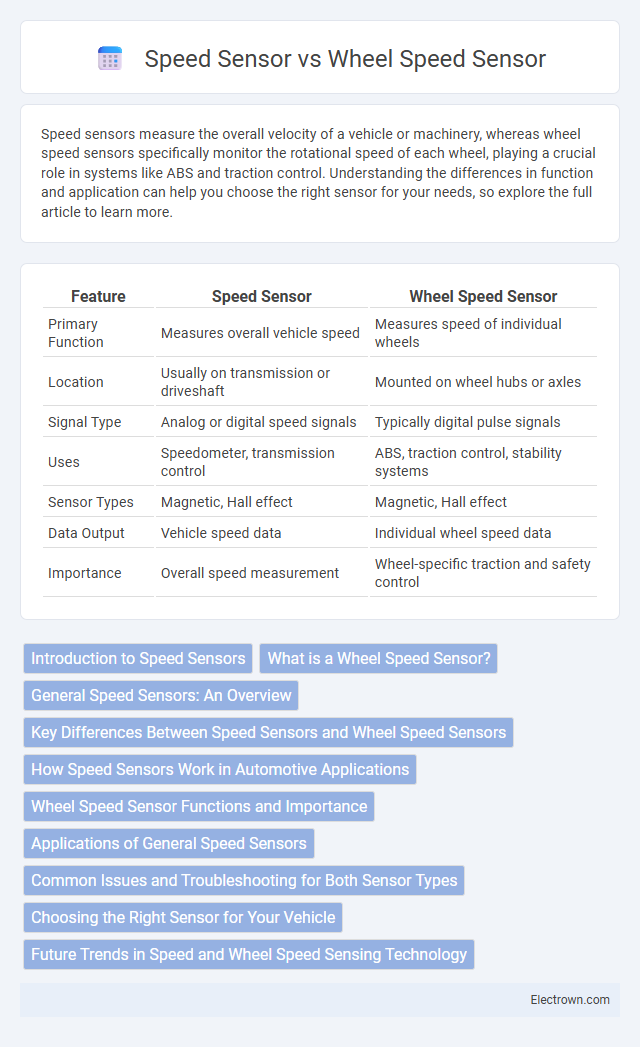Speed sensors measure the overall velocity of a vehicle or machinery, whereas wheel speed sensors specifically monitor the rotational speed of each wheel, playing a crucial role in systems like ABS and traction control. Understanding the differences in function and application can help you choose the right sensor for your needs, so explore the full article to learn more.
Table of Comparison
| Feature | Speed Sensor | Wheel Speed Sensor |
|---|---|---|
| Primary Function | Measures overall vehicle speed | Measures speed of individual wheels |
| Location | Usually on transmission or driveshaft | Mounted on wheel hubs or axles |
| Signal Type | Analog or digital speed signals | Typically digital pulse signals |
| Uses | Speedometer, transmission control | ABS, traction control, stability systems |
| Sensor Types | Magnetic, Hall effect | Magnetic, Hall effect |
| Data Output | Vehicle speed data | Individual wheel speed data |
| Importance | Overall speed measurement | Wheel-specific traction and safety control |
Introduction to Speed Sensors
Speed sensors measure the rotational speed of various mechanical components, providing critical data for systems like engine management and transmission control. Wheel speed sensors specifically monitor the rotational velocity of each wheel, enabling advanced safety features such as anti-lock braking systems (ABS) and traction control. Understanding the distinction between these sensors enhances Your ability to diagnose vehicle performance and safety mechanisms accurately.
What is a Wheel Speed Sensor?
A wheel speed sensor is a critical component in modern vehicles that monitors the rotational speed of each wheel. This sensor provides real-time data to systems like ABS (Anti-lock Braking System) and traction control, enhancing safety and performance. Your vehicle relies on wheel speed sensors to detect wheel slip, enabling precise braking adjustments and improved stability.
General Speed Sensors: An Overview
General speed sensors measure rotational speed or velocity, providing critical data for various mechanical and automotive systems. Wheel speed sensors specifically detect the speed of a vehicle's wheels, enabling precise control in anti-lock braking systems (ABS) and traction control. Your vehicle relies on accurate wheel speed sensor data to optimize safety and performance by monitoring wheel rotation in real time.
Key Differences Between Speed Sensors and Wheel Speed Sensors
Speed sensors measure the overall rotational velocity of various machine components, providing data for engine or system speed control, while wheel speed sensors specifically detect the rotational speed of vehicle wheels for applications like anti-lock braking systems (ABS) and traction control. Wheel speed sensors typically use magnetic or hall-effect technology to monitor each wheel independently, ensuring precise input for vehicle stability systems. In contrast, general speed sensors can employ diverse sensing methods and are not limited to wheel application, offering broader functionality across different mechanical parts.
How Speed Sensors Work in Automotive Applications
Speed sensors in automotive applications detect the rotational velocity of various vehicle components by generating electrical signals based on magnetic or optical changes. Wheel speed sensors specifically monitor the rotational speed of each wheel, providing critical data for anti-lock braking systems (ABS) and traction control to maintain vehicle stability. Your vehicle's speed sensor technology ensures accurate speed measurement, enhancing safety and performance through real-time feedback to the engine control unit (ECU) and braking systems.
Wheel Speed Sensor Functions and Importance
Wheel speed sensors detect the rotational speed of each wheel, providing critical data for anti-lock braking systems (ABS) and traction control. These sensors enable real-time monitoring of wheel movement, ensuring vehicle stability and safety during acceleration, braking, and cornering. Accurate wheel speed measurements help prevent wheel lockup and improve overall driving performance, highlighting their importance in modern automotive technology.
Applications of General Speed Sensors
General speed sensors are used to measure the rotational speed of various mechanical components in automotive, industrial, and consumer electronics applications, enabling precise control and monitoring of motors and shafts. These sensors are critical in systems such as anti-lock braking, transmission control, and factory automation by providing real-time speed feedback to improve performance and safety. Unlike wheel speed sensors that specifically measure vehicle wheel rotation, general speed sensors have a broader application range across multiple industries, including robotics and elevator systems.
Common Issues and Troubleshooting for Both Sensor Types
Common issues with speed sensors and wheel speed sensors include signal loss, sensor misalignment, and wiring faults causing inaccurate speed readings or intermittent data transmission. Troubleshooting involves inspecting the sensor wiring harness for damage, cleaning sensor surfaces to remove debris or metal shavings, and using a diagnostic scanner to identify error codes or measure sensor signal output. You can resolve many problems by verifying sensor alignment and replacing faulty sensors to ensure accurate vehicle speed and ABS system performance.
Choosing the Right Sensor for Your Vehicle
Selecting the right sensor for your vehicle requires understanding their specific functions: a speed sensor measures the rotational speed of engine components, while a wheel speed sensor monitors the wheel's rotation to support ABS and traction control systems. Prioritize a wheel speed sensor if your vehicle relies heavily on safety features like anti-lock braking and stability control for real-time wheel data. For engine performance and transmission management, a speed sensor is essential to ensure accurate measurement of rotating parts and optimal vehicle operation.
Future Trends in Speed and Wheel Speed Sensing Technology
Future trends in speed sensor and wheel speed sensor technology emphasize increased integration with advanced driver-assistance systems (ADAS) and autonomous vehicle platforms, leveraging high-precision MEMS sensors and sensor fusion techniques to enhance accuracy and reliability. Innovations in wireless data transmission and real-time diagnostics will enable faster response times and predictive maintenance, improving overall vehicle safety and performance. The adoption of AI-driven algorithms for sensor data interpretation will further optimize speed measurement accuracy, supporting adaptive vehicle control and smart traffic management systems.
Speed sensor vs Wheel speed sensor Infographic

 electrown.com
electrown.com